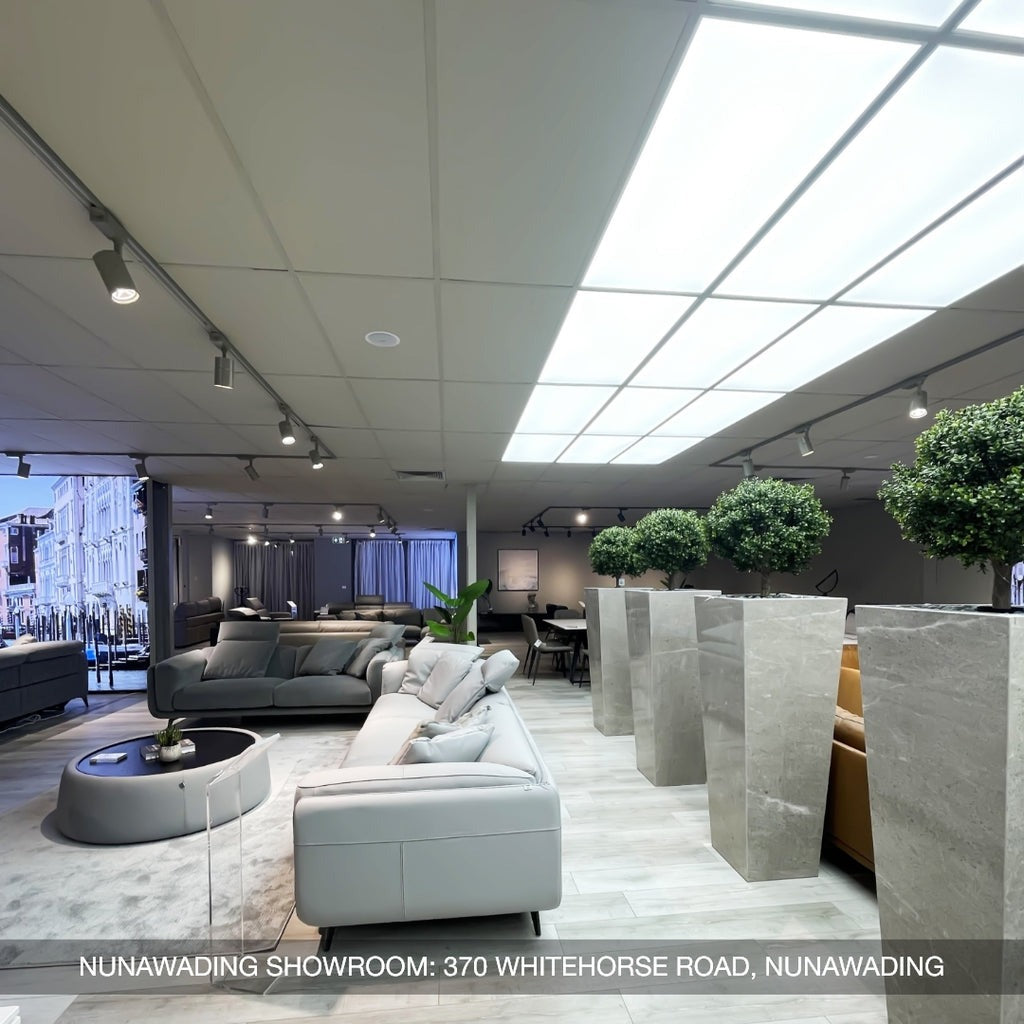Occasional chairs for small spaces or large room offer a versatile seating option that can easily enhance the aesthetics of any room. But with so many styles and designs available, the question arises: should occasional chairs match sofa or stand out as a unique piece? In this guide, we'll explore how to choose occasional chairs that not only complement your existing décor but also provide the comfort and style your living room needs. Whether you're aiming for a cohesive look or a striking contrast, we'll help you make the best choice for your space.
Choosing The Right Shape
The shape of the chair is a crucial factor that can greatly influence both the aesthetics and the practicality of the space. Here’s a detailed breakdown of various shapes and how they can influence the atmosphere of your space:
- Wingback Chair: This type of occasional chair is perfect for adding a touch of tradition to your living room. The high back and 'wings' provide excellent head and neck support, making it an ideal choice for a reading nook or a cozy corner by the fireplace.
- Club Chair: Known for its deep seat and plush cushions, the club chair offers unmatched comfort while maintaining a classic appeal. This type of chair works well in a variety of settings, from modern to traditional living rooms, and is often upholstered in leather for added sophistication.
-
Barrel Chair: With its rounded back and cozy design, the barrel chair creates an inviting, enveloping feel. It's a great option for conversational areas or as an accent piece that stands out due to its unique shape.
-
Slipper Chair: Designed without arms, the slipper chair is a versatile choice for smaller spaces. Its streamlined silhouette allows it to fit comfortably in tight corners or alongside larger furniture pieces without overwhelming the room.
- Bergère Chair: If you’re aiming for a touch of elegance and sophistication, the Bergère chair is your go-to option. With its exposed wooden frame and plush cushions, this chair type exudes a French-inspired charm, making it perfect for more formal living rooms.
In a modern living room, a slipper chair with clean lines and minimalistic upholstery can complement the sleek design of your other furniture. A wingback chair might be the perfect addition to a more traditional setting, where its classic silhouette can anchor the room’s decor. For eclectic or transitional styles, a barrel chair or Bergère chair can add a unique focal point while still blending seamlessly with various decor elements. The right shape not only adds to the visual appeal but also enhances the room's functionality, providing comfortable seating options that meet the needs of your household.

A slipper chair featuring clean lines and simple upholstery can enhance the streamlined look of your existing furniture.
Selecting The Right Size
When selecting the perfect occasional chair, the chair's size should be proportionate to the available space and existing furniture. Here's how to ensure you get it right:
- Start by measuring the area where you plan to place the chair. This includes not just the floor space but also the height available if you’re considering taller chairs like wingbacks.
- Ensure that there is at least 30 inches of clear walking space around the chair. This will prevent the room from feeling cramped and maintain easy movement around the seating area.
In smaller living rooms, careful arranging of living room chairs can make a big difference. Choose occasional chairs that are compact but comfortable, and avoid anything that might dominate the space.
- Opt for smaller designs like slipper chairs, which are armless and low-profile, or small barrel chairs that offer a cozy feel without taking up too much room.
- Steer clear of large, bulky chairs like oversized club chairs, which can overwhelm a small living room and make it feel cluttered.
For larger living rooms, arranging living room chairs becomes an opportunity to create a bold design statement. Bigger chairs not only fill the space but can also become a focal point in the room.
- Consider selecting the perfect occasional chair with larger dimensions, such as wingback chairs or oversized club chairs. These can anchor the space and add a touch of elegance or sophistication.
-
In expansive living areas, using pairs of chairs can help balance the room. Coordinating occasional chairs in pairs can also enhance symmetry and create a more cohesive look.
Remember the chair's proportion relative to your sofa and other seating options. A chair that’s too small may look out of place, while an overly large chair could dominate the room in an unbalanced way.

Opt for an occasional chair with generous dimensions, like a wingback chair or an oversized club chair, to anchor the space and introduce an element of elegance or sophistication.
Choosing The Right Materials
The right material can significantly enhance the overall look of your space while ensuring longevity. Here’s a detailed guide to help you choose occasional chairs that perfectly fit your needs:
Leather
Pros: Leather is a top choice for those looking for a blend of luxury and resilience. It’s highly durable, ages beautifully, and is relatively easy to clean. Over time, leather develops a patina that adds character to the chair, making it a long-term investment.
Cons: However, leather can be on the pricier side, and in colder climates, it may feel less inviting as it retains the coolness of the environment. Consider how this might affect the comfort of your space, especially in winter months.
Fabric (Cotton, Linen, Velvet)
Pros: Fabric offers a wide array of choices in terms of colors, patterns, and textures, allowing for greater creativity in your interior design. It’s also generally more comfortable and can be selected to align with complementing textures and patterns in your living room.
Cons: Despite these advantages, fabric can be prone to stains and typically requires more frequent maintenance to keep it looking its best. This is especially true for lighter fabrics like cotton and linen, which may need protective treatments or regular cleaning.
Microfiber
Pros: For those on a budget, microfiber is a fantastic option. It is known for being stain-resistant and durable, making it ideal for households with children or pets. Its affordability makes it an accessible option without compromising too much on quality.
Cons: On the downside, microfiber may lack the luxurious feel that materials like leather or velvet offer. If you’re looking for a high-end finish, microfiber might not fully meet your expectations.
Wood Accents
The wooden elements of your occasional chairs should harmonize with your existing furniture. Whether it’s the legs, arms, or frame, the wood tone plays a crucial role in ensuring that the chairs integrate seamlessly with your room’s overall decor.
If you prefer low-maintenance furniture, opt for wood finishes that don’t require frequent polishing. Also, consider how the wood will age and whether it will continue to complement your space as it does so.

Leather is an excellent option for anyone seeking a combination of elegance and durability.
Choosing The Right Color
The color you select can either make the chair seamlessly blend with the existing decor or stand out as a striking focal point.
-
Neutral colors (beige, gray, white): Neutral shades are a versatile and timeless choice for your occasional chair. They are ideal for creating a cohesive look that can adapt to future redesigns or changes in your living space. Neutral tones also help in maintaining a calming and elegant atmosphere.
-
Bold colors (red, blue, yellow): Opting for bold colors like red, blue, or yellow allows your chair to become a vibrant centerpiece in your room. These colors are perfect for expressing your personality and adding energy to your space. A bold occasional chair can serve as an eye-catching accent that draws attention and adds depth to the room.
- Patterns: Chairs with patterns can introduce visual interest and texture into your living room. Patterns are an excellent way to tie together various colors in your decor, creating a more dynamic and layered look. They are particularly effective in rooms with a mix of solid colors, adding a touch of complexity and style.
Decide whether you want your chair to be a statement piece that stands out or a subtle addition that blends in. The right color can either harmonize with or contrast against your existing furniture, depending on the look you're aiming for.
Choosing striking colors such as red, blue, or yellow can transform your chair into a lively focal point in your space.
Matching Accent Chairs With A Sofa
Ensuring occasional chairs complement your sofa is key to achieving a balanced and stylish space. The goal is to create a cohesive look where the occasional chair enhances, rather than competes with, your sofa.
-
If your sofa is upholstered in a solid color, consider selecting an occasional chair with a pattern. Conversely, if your sofa features a patterned design, a solid-colored chair can provide balance. This contrast helps create a visually engaging space without overwhelming the senses.
-
The style of your occasional chair should reflect the design of your sofa. For instance, pairing a modern occasional chair with a contemporary sofa, or a traditional chair with a classic sofa, ensures a harmonious look. Consistency in style helps maintain a unified aesthetic throughout the room.
-
Pay attention to the height of the occasional chair in relation to your sofa. A chair that is too tall or too short can disrupt the visual flow and comfort of your seating arrangement. Ensuring proportionality between your chair and sofa will enhance the room’s functionality and appearance.
- To add a layer of visual interest, consider choosing an occasional chair in a color that contrasts with your sofa. This technique can make the chair stand out as an accent piece, contributing to the room's overall depth and character.
Your occasional chair and sofa, they don't need to be an exact match. The key is to create a cohesive look where the elements in the room work together to form a pleasing whole. Achieving this balance allows your living room to feel curated and intentional, rather than haphazard.
Other Things To Consider When Buying Your Occasional Chair
When you’re looking to choose occasional chairs for your living room, there are several factors beyond the basics that you should keep in mind. These considerations will ensure that your selection not only looks great but also serves your needs effectively.
1. Comfort: Comfort should be a top priority, especially if you plan to use the chair frequently. Different types of occasional chairs offer varying levels of comfort, so it's crucial to test the chair if possible. Look for features like cushioned seats, supportive backrests, and ergonomic designs. For example, if you enjoy reading, a chair with a deeper seat and plush upholstery may be ideal. Consider how the chair feels when you sit in it for an extended period, as this will impact your overall satisfaction with the piece.
2. Versatility: One of the key benefits of occasional chairs is their versatility. Choose occasional chairs that can easily transition to other rooms in your home if you decide to redecorate or rearrange your furniture. For instance, a chair that works well in your living room might also be a perfect fit in a bedroom, home office, or even a hallway. Opting for a versatile style and neutral colors will give you more flexibility in how you use the chair over time.
3. Quality: Investing in high-quality construction is essential for longevity. When exploring different types of occasional chairs, pay attention to the materials used in the frame, upholstery, and stitching. Solid wood frames, durable fabrics, and reinforced joints are indicators of a well-constructed chair. Although higher-quality chairs may come with a larger price tag, they tend to withstand wear and tear better, making them a worthwhile investment in the long run.
4. Maintenance: Consider how easy it will be to maintain the chair over time. Different types of occasional chairs require different levels of care. For example, fabric chairs may need regular vacuuming and occasional deep cleaning, while leather chairs might need conditioning to keep them supple. If you have children or pets, you might want to opt for chairs with removable and washable covers or stain-resistant fabrics to keep maintenance manageable.
5. Purpose: Before you choose occasional chairs, think about their primary function in your space. Are you looking for extra seating for guests, a cozy reading nook, or simply a decorative piece that enhances your room’s aesthetic? Each of the occasional chairs are designed for specific purposes, so choose a chair that aligns with how you intend to use it. For example, a wingback chair might be perfect for reading, while an accent chair with a sleek design could serve as a decorative element.
6. Budget: Setting a realistic budget is essential when you choose occasional chairs. Consider the balance between cost, quality, and longevity. While it’s tempting to opt for a cheaper option, investing in a well-made chair can save you money in the long run by avoiding frequent replacements. Evaluate your financial constraints and prioritize spending on key aspects like quality and comfort.
7. Trends vs. Timelessness: Decide whether you want a chair that follows current trends or one that has a timeless appeal. Trendy chairs can add a modern touch to your space but may fall out of favor as design trends change. On the other hand, timeless designs tend to have enduring appeal and can adapt to various decor styles over time. When choosing occasional chairs, consider how long you plan to keep the piece and whether its style will remain relevant in the years to come.
8. Lifestyle: Your lifestyle should heavily influence your choice of occasional chairs. If you have a household with children or pets, consider selecting chairs made from durable materials that can withstand heavy use. For example, a chair with a sturdy frame and easy-to-clean fabric will be more practical in a busy household. Additionally, consider the chair’s stability and safety features if it will be used by younger children.
When you choose occasional chairs that suit your needs and taste, you’re not just adding seating, but also a statement piece that enhances your overall décor. To explore a wide range of options and find the perfect chair for your living room, visit COZY, where you can discover various stylish and high-quality occasional chairs tailored to fit any space.





